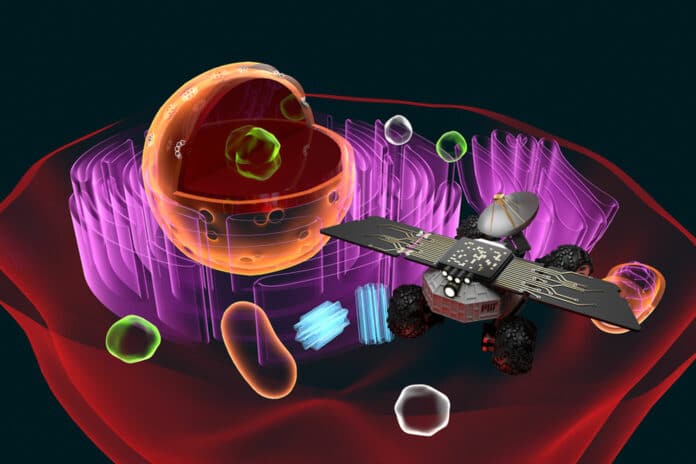A new study could allow scientists to create cyborgs at a cellular scale, thanks to MIT Media Lab for designing a miniature antenna that can operate wirelessly inside a living cell. This could have applications in medical diagnostics, treatment, and other scientific processes because of the antenna’s potential for real-time monitoring and directing cellular activity.
Scientists named this technology Cell Rover. It represents the first demonstration of an antenna that can operate inside a cell and is compatible with 3D biological systems.
Deblina Sarkar, assistant professor and AT&T Career Development Chair at the MIT Media Lab and head of the Nano-Cybernetic Biotrek Lab, said, “Typical bioelectronic interfaces are millimeters or even centimeters in size and are not only highly invasive but also fail to provide the resolution needed to interact with single cells wirelessly — especially considering that changes to even one cell can affect a whole organism.”
The size of the newly developed antenna is much smaller than a cell. The antenna represented less than .05 percent of the cell volume in research with oocyte cells. It converts electromagnetic waves into acoustic waves, whose wavelengths are five orders of magnitude smaller, representing the velocity of sound divided by the wave frequency — than those of the electromagnetic waves.
The miniature antennas are constructed utilizing a substance known as magnetostrictive to achieve this conversion from electromagnetic to acoustic waves. Magnetic domains within the magnetostrictive material align to the field when a magnetic field is applied to the antenna, powering and activating it. This causes strain in the material, much like how metal threads woven into fabric might react to a powerful magnet by twisting.
Baju Joy, a student in Sarkar’s lab and the lead author of this work, said, “When an alternating magnetic field is applied to the antenna, the varying strain and stress (pressure) produced in the material is what creates the acoustic waves in the antenna. We have also developed a novel strategy using a non-uniform magnetic field to introduce the rovers into the cells.”
Sarkar said, “Configured in this way, the antenna could be used to explore the fundamentals of biology as natural processes occur. Instead of destroying cells to examine their cytoplasm as is typically done, the Cell Rover could monitor the development or division of a cell, detecting different chemicals and biomolecules such as enzymes or physical changes such as cell pressure — all in real-time and in vivo.”
The researchers claim that materials like polymers, which are already used in medical and other research, could be integrated with the operation of the Cell Rover. Polymers, for instance, change in mass or stress in response to chemical or biomolecular changes. A combination like this might reveal information that the cell-destroying methods of observation currently in use do not.
Sarkar explained, “With such capabilities, the Cell Rovers could be valuable in cancer and neurodegenerative disease research, for example. The technology could detect and monitor biochemical and electrical changes associated with the disease over its progression in individual cells. Applied in the field of drug discovery, the technology could illuminate the reactions of live cells to different drugs.”
“Because of the sophistication and scale of nanoelectronic devices such as transistors and switches — “representing five decades of tremendous advancements in the field of information technology. The Cell Rover, with its mini antenna, could carry out functions ranging from intracellular computing and information processing to autonomous exploration and modulation of the cell. The research demonstrated that multiple Cell Rovers can be engaged, even within a single cell, to communicate among themselves and outside of the cells.”
Anantha P. Chandrakasan, dean of the MIT School of Engineering and the Vannevar Bush Professor of Electrical Engineering and Computer Science, said, “The Cell Rover is an innovative concept as it can embed sensing, communication, and information technology inside a living cell. This opens up unprecedented opportunities for exact diagnostics, therapeutics, and drug discovery, as well as a new direction at the intersection between biology and electronic devices.”
Journal Reference:
- Joy, B., Cai, Y., Bono, D.C. et al. Cell Rover—a miniaturized magnetostrictive antenna for wireless operation inside living cells. Nat Commun 13, 5210 (2022). DOI: 10.1038/s41467-022-32862-4
